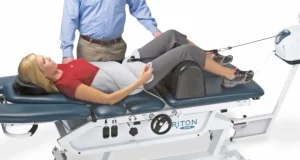 Patients who suffer from the chronic pain associated with bulging, degenerating, or herniated discs may benefit from treatment using a spinal decompression table. This type of pain, which can manifest as back or neck pain itself as well as associated pain in the arms and legs, may have already been treated by traditional traction methods or even by spinal surgery to limited improvement. In these cases, a spinal decompression table that uses computerized sensors to perform stretching actions on the spine and promote healing can be uniquely effective. But what is a spinal decompression table, and how it can be used to treat patients who have not been able to find relief in other ways?
Patients who suffer from the chronic pain associated with bulging, degenerating, or herniated discs may benefit from treatment using a spinal decompression table. This type of pain, which can manifest as back or neck pain itself as well as associated pain in the arms and legs, may have already been treated by traditional traction methods or even by spinal surgery to limited improvement. In these cases, a spinal decompression table that uses computerized sensors to perform stretching actions on the spine and promote healing can be uniquely effective. But what is a spinal decompression table, and how it can be used to treat patients who have not been able to find relief in other ways?
What is Spinal Decompression Therapy?
Spinal decompression therapy, also known as non-surgical spinal decompression, is a practice that utilizes spinal decompression tables to relieve pain by creating a scenario in which bulging or herniated disc tissue is able to move back into place and heal, alleviating the pain this condition causes.
Spinal decompression therapy aims to help patients who suffer from debilitating pain due to bulging, degenerating, or herniated discs. It Pcan also be used for the pain management and treatment of many causes of sciatica, injured or diseased spinal nerve roots, and worn spinal joints.
The therapy itself works to stretch the spine, using a spinal decompression table or other device, in order to create negative pressure and space within the disc to allow disc fluid to move back into place. This creates an environment in which the disc can receive more nutrients and therefore heal itself more quickly and effectively. The ultimate goal of spinal decompression therapy is to relieve the patient’s chronic back, arm, neck, and/or leg pain, and to heal the source of said pain.
Spinal decompression therapy is also referred to as non-surgical decompression therapy, since it is often used as a safe, affordable, and extremely effective alternative to spinal surgery. The distinction between surgical and non-surgical spinal decompression is an important one, as surgical spinal procedures are often considered a last option, while spinal decompression therapy is a safe treatment at any stage of back pain. The most common spinal decompression surgeries are laminectomy and microdiscectomy, which present a greater risk of complication or failure.Spinal Decompression Table Research
Research into spinal decompression therapy is ongoing, with a number of studies showing benefits to patients experiencing chronic or acute pain. For instance, a study from the Rio Grande Regional Hospital and Health Sciences Center and the University Texas showed:
The specific and important clinical action of decompression therapy that makes it effective. Intradiscal pressure measurement was performed by connecting a cannula inserted into the patient’s L4-L5 disc space to a pressure transducer. Spinal decompression was introduced and changes in pressure were recorded at a resting state and again while controlled tension was applied by the equipment. The results of this study indicate that it is possible to lower pressure in the nucleus pulposus of herniated lumbar discs to below -100 mm Hg when distraction tension is applied according to the protocol described for decompression therapy. The lowest intradiscal pressure measured during progressive traction was 40 mm Hg compared to 75 mm Hg resting supine.(2) Standard decompression therapy, therefore, differs from standard traction by creating a unique clinical circumstance of prolonged negative intradiscal pressure.
Lowering the pressure in a herniated disc is the objective way to measure whether decompression is working, since lower pressure means, by definition, less compression. When the pressure within a lumbar disc is lower, patients will experience less low-back pain.
In an outcome study from 1998, spinal decompression therapy was effective in 71% of cases, with patients reporting a decrease in pain to either 0 or 1 on a scale of 0 to 5.
Another low-back pain study found that patients with chronic pain experienced relief from spinal decompression therapy in as little as eight weeks. It is important to note that 80% of the patients in this particular study had been experiencing symptoms for more than 6 months and had tried at least two other interventions to relieve their pain before turning to a spinal decompression table.
For years, patients have depended on me to provide this valuable service. I offer this and other specialized options to anyone in need of a Doctor of Chiropractic they can trust. I’m Cibelle Chiropractic of Georgetown, and I’m dedicated to building long-lasting relationships based on trust and medical integrity with every single patient.
Through this and other services, I’ve cared for numerous patients throughout my career as a Doctor of Chiropractic. To me, nothing matters more than your health and comfort, which is why I’ve put in so much time and effort into advancing my medical practice and techniques. Please get in touch to schedule an initial consultation.
